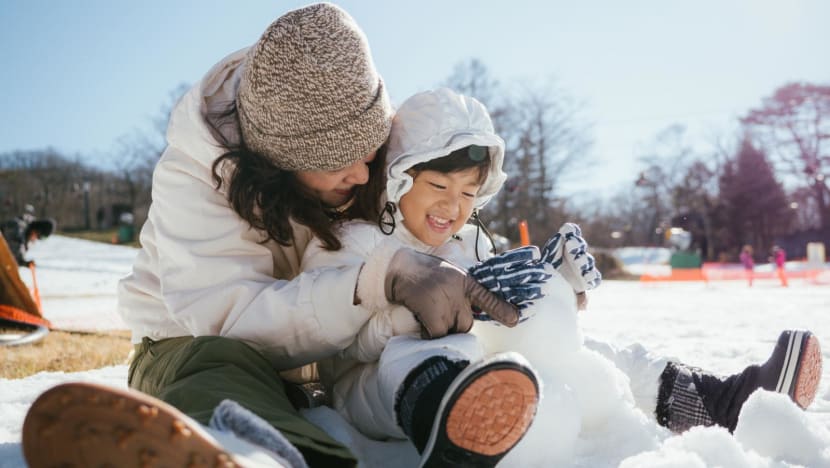Commentary: Is it worth sending your preschooler on a costly exchange programme they might not remember?
Is it “worth” sending young children on cultural immersion programmes abroad? Mum-of-three Cherie Tseng weighs in on the real costs and gains.

What's the difference between spending a couple grand for “kindy in a different country” versus a typical ski trip? (Photo: iStock)

This audio is generated by an AI tool.
SINGAPORE: No one disputes the fact that raising children is expensive business. Cost of living and academic fortification make up the lion’s share of expenses – then there are the other things: Smartphones and other devices, tickets to where’s where to catch the who’s who, and even little troll-like collectible dolls.
Last week, the greater parenting community learnt of another item we could add to our inexhaustible repertoire of things-we-do-for-our-children: Kindergarten exchange programmes.
Reactions to CNA’s Dec 23 report of Singaporean parents shelling out thousands to send their preschoolers on exchange programmes in Japan ranged from scepticism to outright disbelief.
The chatter – and critique – over this was two-pronged: The price (so extravagant!) and the age of the child (too young to remember anything!). What could a six-year-old possibly gain from a week or two of experiences that they might not remember in another 10 years? And is that gain worth such a steep price tag?
IS IT “TOO MUCH”?
Clearly, for some parents making these choices, the rationale goes beyond tangible outcomes or immediate academic returns.
Such parenting investments are about exposure and experience building: Little Andrew gets exposed to different cultures, languages and ways of thinking at an age where he’s still forming his core worldviews.
The hope is that these early experiences will lay a different sort of foundation that will enable children to be more adaptable, confident and globalised in their mindset.
Still, it’s fair to question: At such a young age, is a pricey overseas exchange programme truly the best way to build cultural fluency? Does the price tag align with the programme’s and parents’ desired outcomes?
Most of all, where is the line between an “exchange programme” and a fancy vacation with an academic learning slant with structured activities?
The key difference lies in the framing.
The sensing is that a couple grand for “kindy in a different country” feels extravagant.
CNA’s article put the cost of a one-week trip at about S$3,000 for a parent and a child. That works out to about S$428 a day.
In comparison, a three-day stay at Disney Resort for one adult and child would cost a little more – and that’s taking the low end of the estimate. A typical ski trip comes in at about the same too, not counting lessons.
So why do we baulk at kindy exchange while envying and applauding the Disney-goers and the ski trippers?
IS TRAVEL JUST FOR LEISURE?
Disneyland or a ski trip is marketed as leisure – something we do as a treat for both parent and child. These are bonding experiences with lots of photo opportunities laced with a sheen of social signalling.
But a ski resort or theme park operates in a bubble. They are curated experiences that are designed and standardised to deliver guaranteed but predictable enjoyment. We can meet people from different countries at the ski lodge, but these interactions are often fleeting and transactional.
Experiences rooted in cultural immersion carry a depth that commercial holidays can struggle to replicate.
Something like a kindergarten exchange programme invites participants to step into spaces where we are guests rather than customers. The surrounding context is not tailored for our comfort or pleasure. It simply is, in all its unfamiliarity.
From eating unfamiliar foods, to navigating different social norms and customs, or even just the stark realisation that our way of life isn’t the only way – these moments plant seeds of resilience, adaptability and curiosity.
A child who’s learnt to ski on Hokkaido’s fresh powder might come home with the same wide-eyed wonder as the little girl who learnt to make sushi rolls with her new Japanese BFF. Both are memorable and deeply shaped by how parents help kids to reflect and build on them after the fact.
Perhaps the social conversation we should be having on this is less about where a family chooses to go and what exactly they do there, but why and how they choose to go about it. Are we curating trips like a shopping list, racing from one activity or tourist hot spot to the next? Or do we leave space for reflection, curiosity and connection?
TEACHING KIDS TO TRAVEL WITH INTENTION
Last year, our family headed to Seoul for a short vacation during the June holidays. Included in the itinerary: A trip to the popular Alpaca World that all three of my sons were quite excited for, and a day’s outing to the Demilitarized Zone (DMZ) which ranked far lower on the excitement meter for the boys.
True to form, Alpaca World had high entertainment value. I squealed in delight as hordes of alpacas rushed down the hill in a feeding frenzy. We spent hours walking about the park looking at cute animals; but really, we learnt virtually nothing about alpacas beyond the cursory.
In comparison, the DMZ was heavy going, weighed down by a sense of formality and seriousness throughout.
My sons dutifully followed our guide from one war monument to another. They peered through viewing devices into North Korea. They listened to the loud music blasting through loudspeakers on both sides. They even gamely trekked down to see the Third Tunnel of Aggression.
At Freedom Bridge, they listened sombrely as our guide told us about North-South family reunions and how war has shaped Korean cuisine (army stew was born out of scavenging of edible scraps from American military installations and dakgalbi is rife with lettuce because it was cheap and filling).
Months later, no one talks about Alpaca World.
Every now and then, we find ourselves discussing something we learnt from that “less exciting” DMZ outing.
My eldest, aged 14, talks about why statements like “the Japanese have finer cuisine” don’t take into account the full picture. My second-born, post-PSLE, expresses distress that one country’s version of history could be so markedly different from another’s. My seven-year-old finds it “gross” that poop-bombs are a war tactic.
Singapore’s own National Gallery Museum encourages a three-prong method to start conversations about art: See, think, wonder. I’ve adopted this for a whole myriad of things, including travel.
Whether you are at the DMZ, Disneyland or a cultural programme in the middle of a rural Japanese town, “see think wonder” invites you to pause, engage and ask questions. It reminds us to be present and curious, regardless of where we are and what we’re doing.
Whether we’re at a border zone, a museum, or even a playground what we get out of it is up to us. Are we focusing on experience or optics? Reflection or activity? Presence or performance?
That’s what makes all the difference between a trip that ends when the bags are unpacked, and one that lingers in meaningful ways long after.
Cherie Tseng is Chief Operations Officer at a local fintech company, a mother of three and editor with The Birthday Collective.


















